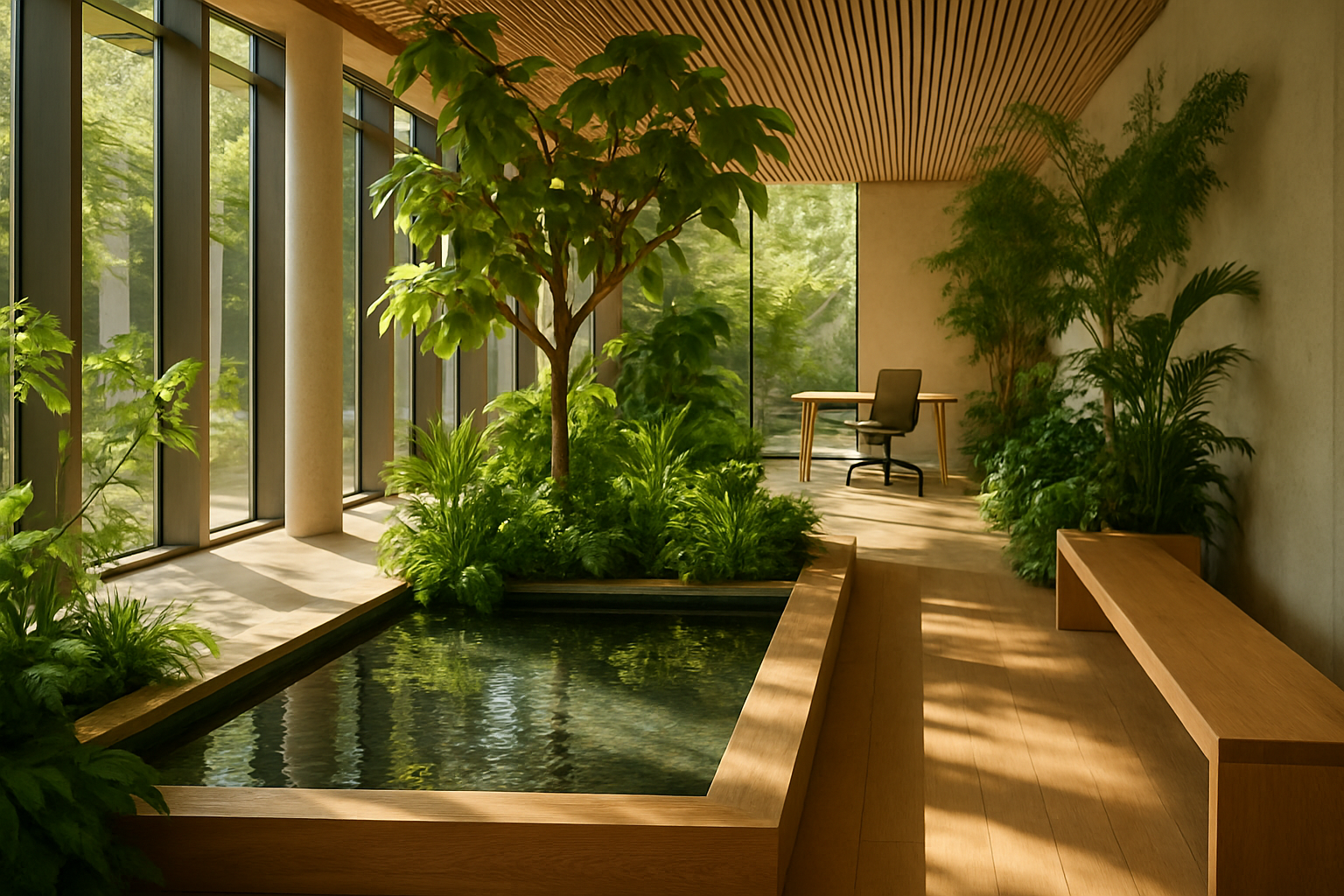Biophilic Design: Nature-Inspired Spaces for Optimal Health
Are you feeling disconnected from nature in your daily life? Imagine stepping into a workspace bathed in natural light, surrounded by lush greenery and the soothing sound of flowing water. This is the essence of biophilic design, a revolutionary approach to creating environments that foster human well-being by integrating natural elements into our built spaces. But how exactly does this innovative concept impact our health, and why is it gaining traction in wellness circles worldwide?

The Origins of Biophilic Design
Biophilic design stems from the biophilia hypothesis, first proposed by esteemed biologist Edward O. Wilson in 1984. Wilson suggested that humans have an innate affinity for nature, developed through millennia of evolution in natural environments. This concept laid the foundation for biophilic design, which aims to satisfy our inherent need for nature connection in modern built environments.
The principles of biophilic design have roots in ancient architectural practices, where elements of nature were often incorporated into buildings for both practical and aesthetic purposes. However, it wasn’t until the late 20th century that researchers began to scientifically explore the health benefits of nature-inspired spaces, leading to the formalization of biophilic design as a distinct field.
The Science Behind Nature’s Health Benefits
Numerous studies have demonstrated the positive effects of nature exposure on human health. Research shows that even brief interactions with natural elements can reduce stress, lower blood pressure, and improve cognitive function. A landmark study published in the journal Environmental Health Perspectives found that office workers with views of nature reported higher job satisfaction and fewer health complaints compared to those without access to natural views.
Moreover, exposure to natural light and circadian-friendly lighting has been shown to improve sleep quality and overall well-being. A study in the Journal of Clinical Sleep Medicine revealed that office workers with more exposure to natural light experienced better sleep and reported higher quality of life scores compared to those with less natural light exposure.
Key Elements of Biophilic Design
Biophilic design incorporates various elements to create spaces that mimic or evoke natural environments. These elements can be broadly categorized into direct nature experiences, indirect nature experiences, and space and place conditions.
Direct nature experiences include the incorporation of living plants, water features, and natural light into built environments. Indoor gardens, green walls, and skylights are examples of direct nature elements that can be integrated into buildings.
Indirect nature experiences involve representations of nature, such as nature-inspired artwork, natural materials like wood and stone, and biomorphic forms that mimic natural shapes and patterns. These elements can evoke the feeling of being in nature even in fully enclosed spaces.
Space and place conditions refer to the overall spatial arrangement and environmental qualities that create a sense of refuge, prospect, and mystery, similar to what we experience in natural settings. This can include creating spaces with varying ceiling heights, incorporating natural ventilation, and designing spaces that encourage movement and exploration.
Implementing Biophilic Design in Various Settings
Biophilic design principles can be applied in a wide range of settings, from homes and offices to healthcare facilities and educational institutions. In the workplace, biophilic design has been shown to increase productivity, creativity, and employee well-being. Companies like Amazon and Google have incorporated extensive biophilic elements in their office spaces, recognizing the benefits for their employees.
In healthcare settings, biophilic design can contribute to faster recovery times and reduced stress for patients. A study published in the journal Health Environments Research & Design found that patients in rooms with views of nature had shorter postoperative stays and took fewer pain medications compared to those in rooms without nature views.
Educational institutions are also embracing biophilic design to create more conducive learning environments. Research has shown that classrooms with natural light and views of nature can improve student performance and reduce absenteeism.
Challenges and Future Directions
While the benefits of biophilic design are clear, implementing these principles on a large scale comes with challenges. Cost considerations, maintenance requirements for living elements, and the need for interdisciplinary collaboration between architects, designers, and health professionals are some of the hurdles that need to be addressed.
However, as awareness of the health benefits of biophilic design grows, we are likely to see more innovative solutions and widespread adoption of these principles. Advancements in technology, such as smart lighting systems that mimic natural light patterns and virtual reality nature experiences, are opening up new possibilities for bringing nature into our built environments.
Biophilic Design: Practical Tips for Healthier Spaces
-
Incorporate indoor plants to improve air quality and create a connection to nature
-
Maximize natural light through strategic window placement and use of reflective surfaces
-
Use natural materials like wood and stone in interior finishes
-
Install water features to introduce soothing sounds and visual interest
-
Create visual connections to outdoor green spaces where possible
-
Use nature-inspired patterns and textures in fabrics and wall coverings
-
Implement circadian lighting systems to support natural sleep-wake cycles
-
Design flexible spaces that allow for movement and varied postures
-
Include artwork depicting natural scenes or elements
As we continue to spend more time indoors, the importance of creating healthier, nature-inspired spaces becomes increasingly evident. Biophilic design offers a powerful approach to improving our physical and mental well-being by reconnecting us with the natural world. By incorporating elements of nature into our built environments, we can create spaces that not only look beautiful but also actively contribute to our health and happiness. As research in this field progresses, we can expect to see biophilic design principles becoming an integral part of how we conceive and construct the spaces where we live, work, and heal.





